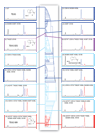Quantitative exploration of the catalytic landscape separating divergent plant sesquiterpene synthases
- PMID: 18776889
- PMCID: PMC2664519
- DOI: 10.1038/nchembio.113
Quantitative exploration of the catalytic landscape separating divergent plant sesquiterpene synthases
Abstract
Throughout molecular evolution, organisms create assorted chemicals in response to varying ecological niches. Catalytic landscapes underlie metabolic evolution, wherein mutational steps alter the biosynthetic properties of enzymes. Here we report the first systematic quantitative characterization of the catalytic landscape underlying the evolution of sesquiterpene chemical diversity. On the basis of our previous discovery of a set of nine naturally occurring amino acid substitutions that functionally interconverted orthologous sesquiterpene synthases from Nicotiana tabacum and Hyoscyamus muticus, we created a library of all possible residue combinations (2(9) = 512) in the N. tabacum enzyme. The product spectra of 418 active enzymes revealed a rugged landscape where several minimal combinations of the nine mutations encode convergent solutions to the interconversions of parental activities. Quantitative comparisons indicated context dependence for mutational effects--epistasis--in product specificity and promiscuity. These results provide a measure of the mutational accessibility of phenotypic variability in a diverging lineage of terpene synthases.
Figures







References
-
- Grayer RJ, Kokubun T. Phytochemistry. 2001;56(3):253. - PubMed
-
- Pedras MSC, Okanga FI, Zaharia IL, et al. Phytochemistry. 2000;53(2):161. - PubMed
-
- Harborne JB. Biochemical Systematics and Ecology. 1999;27(4):335. - PubMed
-
- Akiyama K, Matsuzaki K, Hayashi H. Nature. 2005;435(7043):824. - PubMed
-
- Mumm R, Hilker M. Chemical Senses. 2005;30(4):337. - PubMed
Publication types
MeSH terms
Substances
Grants and funding
LinkOut - more resources
Full Text Sources
Other Literature Sources

